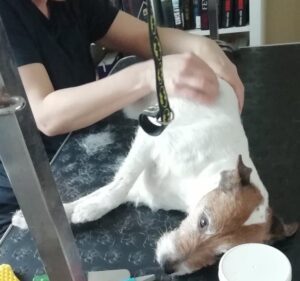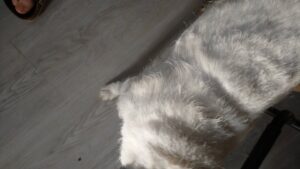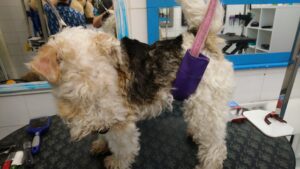… how to and answers to some questions.
1. Stretch the skin above the area where you pull
The skin on terriers are quite lose. Skin doesn’t just “float” on the body, it is connected through tissue. If you strip without stretching the skin tight above the area you are working on, then the skin really “wobbles” around. You are likely to hurt the dog and you can cause damage to the connective tissue. Most dogs find this sensation really uncomfortable, and you will get a reaction from them!
On this picture you can see that I am holding the skin tight with my left hand while I am pulling hair with the right. The only reason why his eyes are open is the fact that someone took a picture.

2. Keep your wrist straight and lock it there
You are using your fingers like a tweezer and if you use a tool then you tweeze the hair between the tool and your thumb.
If you are working only with your fingers, it’s the index finger and the thumb which you are working with. The main action does neither come from your wrist, nor from your shoulder, but from moving your lower arm towards you, so essentially from just using your elbow joint in an ergonomically correct way.
If you use your wrist then you are very likely to twist, which then causes you pain in the hands after a short while leading up to carpal tunnel syndrome on a mid- to long-term. It will likely also cause micro damage within the dogs skin (e.g. pullin the arrector pili muscle) as you cannot pull the hair in the direction it grows.
Best way to learn the correct technique is to book a one day course with an experienced person (a breeder, show handler or a qualified groomer) and work with them. Let them show you how to do it and work under supervision. If that’s not possible, then take a video of you working and learn from your mistakes. You could also watch videos on youtube – there is a lot of quality out there meanwhile – but this is not doing it yourself of course.
3. Pull into the direction of hair growth
During development and growth hair is connected to the skin in more than one way. There are tiny muscles which can move the hair up (“goosebumps” in humans and e.g. raised hackles in dogs).
Although the hair we are talking about has reached the end of its lifecycle and is not directly connected anymore it still sits in the follicle. Pulling it in a different direction than it naturally lays, can therefore hurt the skin, the connected muscles (arrector pili muscle for those who want to do research) and connective tissue.
On the body and top of the head it is quite easy: you can sit behind the dog an pull away, but …
Look where and how the hair grows here. Front to back, inside out, outside in, a “seam” on the neck where both directions meet, and then we have some cowlicks, too.

Flatwork describes the areas where the hair is supposed to be very flat against the body: throat, breast and the back end of the dog. This and the belly are the most sensitive and vulnerable parts of the dog – imagine an enemy coming for it: it would definitely go for those soft parts of the body. That’s why it often takes time for the dog giving in, trusting you and getting used to be handstripped on those parts of the body. This is purely instinct and not the dog “being difficult”.
When my dog is quite relaxed, he often turns on his back and then I can strip all those parts including the belly. That was the opportunity to create this picture.
I do not have the skills of a contortionist to be honest, I pluck those hair when he is asleep just like that. If he is awake, standing on the grooming table, it is a matter of handling him correctly.
The dog and you need to work together and this is certainly a matter of training (for you and your dog). E.g. lift the head, which has the nice side effect that the skin is already stretched when I start to strip under the chin. I then can also stand upright or sitting on his side, not bending myself into a knot or start to twist my limbs.
4. Don't fall out with your dog
With terriers who are bred to make independent decisions you sometimes need to overrule their ideas, but of course in a positive and pleasant way.
I remember one Irish Terrier who “told” me clearly – through body language, not growling – that he didn’t like being stripped on the sides of his neck, so I didn’t stop, but moved to a different part on top of the neck and came back later to finish the side. I “listened” to the dog, but didn’t give in – or give up entirely.
Don’t fall out with your terrier, work “with” not against the animal, as they will remember the experience and life is likely going to be way more difficult for both of you if you force them through a procedure.
They will remember.
Further questions: Thick coat, the dog is hot, what to do
I have had several private and public discussions when commenting in social media groups and here are some answers.
Thick coat – the dog is hot, would clipping it help to reduce heat?
If you clip or scissor all the hair stays. Only shorter.
If you brush, comb, rake, card or handstrip then the dead hair goes. Less insulation, more airflow in a TERRIER coat.
Please go to More knowledge where I shared very useful links. This topic is quite complex, specifically when it comes to so called “double coated” and “Nordic breeds”. Every summer there is lots of drama going on about this topic – mostly from people who do not educate themselves and repeat only what the aunt of the hairdressers dog heard from a neighbour who knows someone …
This is an image of thick coat on the neck. The dog in question is “broken coated” – on the body the coat resembles more a smooth coat and this needs brushing (deshedding) regularly. The coat on the neck benefits from carding the undercoat and then stripping the top coat.

Here you can see how the neck looks like when it is scissored (a clipper would have the same effect).
It might look tidy and nice from the outside, but the old hair is still there. In that case grooming was predominantly for a neat and tidy look and not the benefit of skin or adding airflow.

Further questions: Thick coat and the hair doesn't come out
Hold the skin really tight over the area where you want to pull. Terriers have a loose skin, you can even make a roll of it and hold that roll without bothering them. When the coat is that dense we recommend first using a brush and then use a TwinKing 2in1 , getting the bulk of undercoat out and ease access to the rest of hair, then card the rest with a carding knife. After that you can work on the top coat. This is a Wire Fox Terrier with about 3 months of coat growth.
I want to learn - who can help me?
When in doubt, ask your breeder to show you how to do it. If s/he is not available, you can also ask a qualified groomer to show you.
What is “qualified” and why?
The grooming industry is still unregulated. To open a salon you do not need to have any qualifications as of yet, not even First Aid.
On the other hand there are three Ofqual regulated qualifications (iPet, OCN, City & Guilds) and one accredited course (ICMG) available. They all include handstripping in their curriculum. So those groomers know what it is and should be able to show you the correct and safe technique.
You can also watch video tutorials or ask in the open and educational facebook group for help, but Internet has its limits. Once you have learned the wrong technique – and practised – it will be very hard to re-learn.
This is a review we received doing exactly this: helping an owner who heard about handstripping, but wasn’t sure about how and where to start:

If you are in the same situation you can always contact us: info@pluckandshine.com
And if you are not too far away from Sussex you can find us in Pulborough at Dolly’s Dog Grooming & Spa. Sessions only by appointment.
